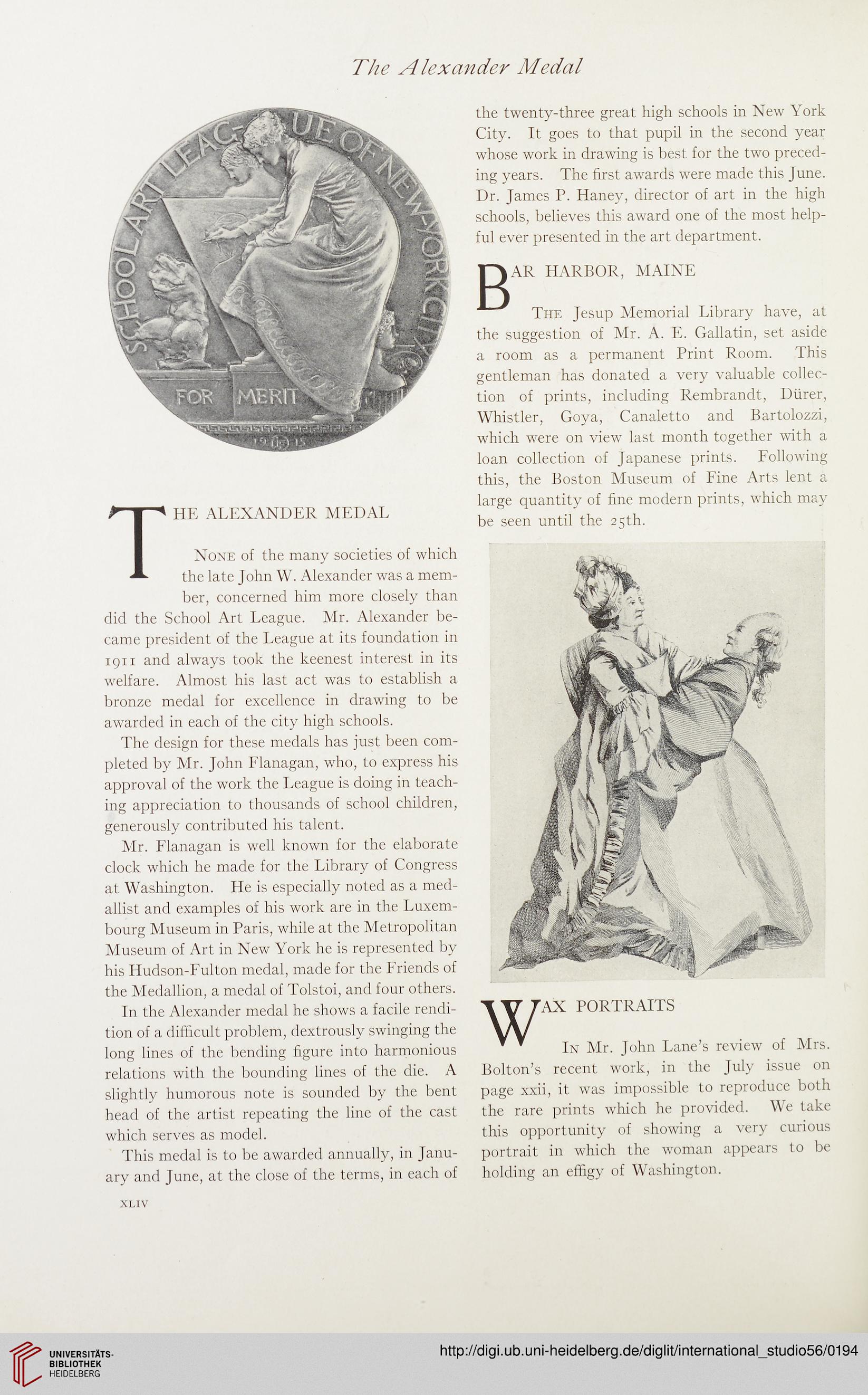The Alexander Medal
THE ALEXANDER MEDAL
None of the many societies of which
the late John W. Alexander was a mem¬
ber, concerned him more closely than
did the School Art League. Mr. Alexander be-
came president of the League at its foundation in
1911 and always took the keenest interest in its
welfare. Almost his last act was to establish a
bronze medal for excellence in drawing to be
awarded in each of the city high schools.
The design for these medals has just been com-
pleted by Mr. John Flanagan, who, to express his
approval of the work the League is doing in teach-
ing appreciation to thousands of school children,
generously contributed his talent.
Mr. Flanagan is well known for the elaborate
clock which he made for the Library of Congress
at Washington. He is especially noted as a med-
allist and examples of his work are in the Luxem-
bourg Museum in Paris, while at the Metropolitan
Museum of Art in New York he is represented by
his Hudson-Fulton medal, made for the Friends of
the Medallion, a medal of Tolstoi, and four others.
In the Alexander medal he shows a facile rendi-
tion of a difficult problem, dextrously swinging the
long lines of the bending figure into harmonious
relations with the bounding lines of the die. A
slightly humorous note is sounded by the bent
head of the artist repeating the line of the cast
which serves as model.
This medal is to be awarded annually, in Janu-
ary and June, at the close of the terms, in each of
the twenty-three great high schools in New York
City. It goes to that pupil in the second year
whose work in drawing is best for the two preced-
ing years. The first awards were made this June.
Dr. James P. Haney, director of art in the high
schools, believes this award one of the most help-
ful ever presented in the art department.
\ HARBOR, MAINE
The Jesup Memorial Library have, at
the suggestion of Mr. A. E. Gallatin, set aside
a room as a permanent Print Room. This
gentleman has donated a very valuable collec-
tion of prints, including Rembrandt, Diirer,
Whistler, Goya, Canaletto and Bartolozzi,
which were on view last month together with a
loan collection of Japanese prints. Following
this, the Boston Museum of Fine Arts lent a
large quantity of fine modern prints, which may
be seen until the 25th.
Bolton’s recent work, in the July issue on
page xxii, it was impossible to reproduce both
the rare prints which he provided. We take
this opportunity of showing a very curious
portrait in which the woman appears to be
holding an effigy of Washington.
XLIV
THE ALEXANDER MEDAL
None of the many societies of which
the late John W. Alexander was a mem¬
ber, concerned him more closely than
did the School Art League. Mr. Alexander be-
came president of the League at its foundation in
1911 and always took the keenest interest in its
welfare. Almost his last act was to establish a
bronze medal for excellence in drawing to be
awarded in each of the city high schools.
The design for these medals has just been com-
pleted by Mr. John Flanagan, who, to express his
approval of the work the League is doing in teach-
ing appreciation to thousands of school children,
generously contributed his talent.
Mr. Flanagan is well known for the elaborate
clock which he made for the Library of Congress
at Washington. He is especially noted as a med-
allist and examples of his work are in the Luxem-
bourg Museum in Paris, while at the Metropolitan
Museum of Art in New York he is represented by
his Hudson-Fulton medal, made for the Friends of
the Medallion, a medal of Tolstoi, and four others.
In the Alexander medal he shows a facile rendi-
tion of a difficult problem, dextrously swinging the
long lines of the bending figure into harmonious
relations with the bounding lines of the die. A
slightly humorous note is sounded by the bent
head of the artist repeating the line of the cast
which serves as model.
This medal is to be awarded annually, in Janu-
ary and June, at the close of the terms, in each of
the twenty-three great high schools in New York
City. It goes to that pupil in the second year
whose work in drawing is best for the two preced-
ing years. The first awards were made this June.
Dr. James P. Haney, director of art in the high
schools, believes this award one of the most help-
ful ever presented in the art department.
\ HARBOR, MAINE
The Jesup Memorial Library have, at
the suggestion of Mr. A. E. Gallatin, set aside
a room as a permanent Print Room. This
gentleman has donated a very valuable collec-
tion of prints, including Rembrandt, Diirer,
Whistler, Goya, Canaletto and Bartolozzi,
which were on view last month together with a
loan collection of Japanese prints. Following
this, the Boston Museum of Fine Arts lent a
large quantity of fine modern prints, which may
be seen until the 25th.
Bolton’s recent work, in the July issue on
page xxii, it was impossible to reproduce both
the rare prints which he provided. We take
this opportunity of showing a very curious
portrait in which the woman appears to be
holding an effigy of Washington.
XLIV




